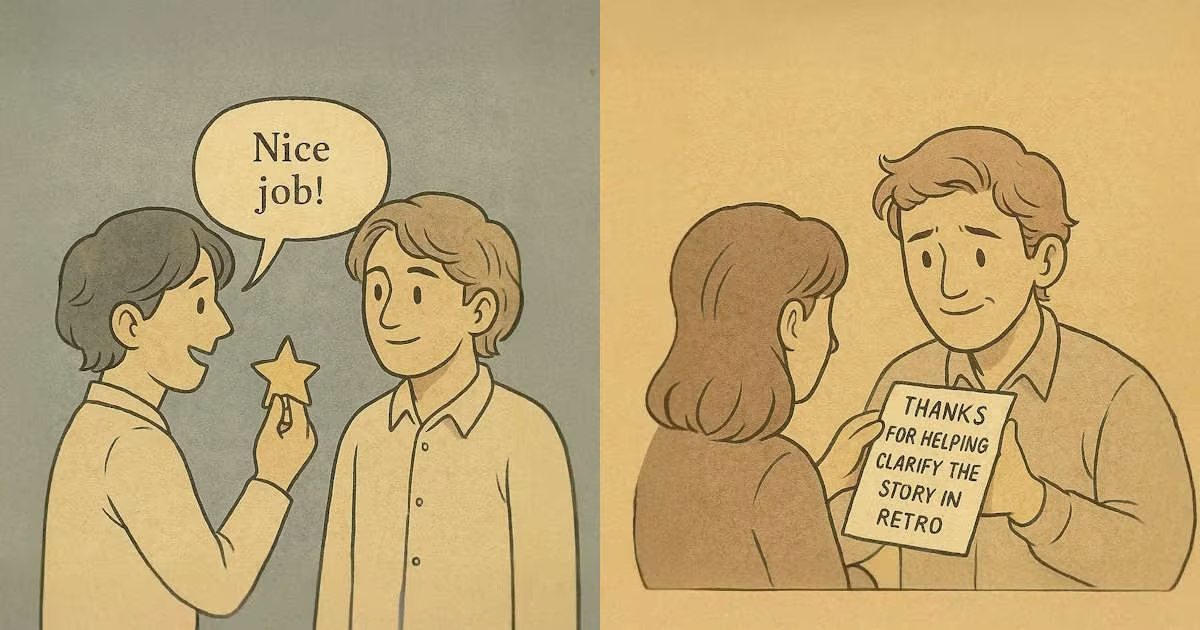
More Than a Compliment: How Real Appreciation Builds Stronger Teams
Two Powerful Tools, One Big Confusion
In fast-paced teams, praise is often thrown around like confetti:
“Nice job!”
“Well done!”
“Awesome work!”
It feels good, and it’s better than silence, but is it enough?
There’s a big difference between giving a compliment and expressing real appreciation. And if you want your team to be motivated, engaged, and connected, that difference matters more than you think.
Compliment vs. Appreciation: What’s the Difference?
At first glance, compliments and appreciation seem similar. They’re both positive and both directed at someone’s work or behavior.
But the intent, depth, and effect are different.
| Compliment | Appreciation |
|---|---|
| “Nice work on that!” | “I really appreciated how you handled that bug fix, especially under time pressure.” |
| General or vague | Specific and contextual |
| Focuses on outcome | Acknowledges effort, intent or value alignment |
| Momentary feel-good | Builds lasting trust and motivation |
Compliments are usually quick responses to results. Appreciation is intentional, tied to behavior, and grounded in shared values or goals.
Why Compliments Alone Fall Short
Compliments are easy to give. But they often feel:
- Generic: “Good job!” on what? Why?
- Transactional: They can seem like social grease instead of real recognition
- Empty: Without context, they don’t connect to effort or purpose
According to Harvard Business Review, people value recognition more when it’s peer-to-peer, specific, and clearly tied to meaningful work.
What Real Appreciation Sounds Like
Appreciation goes deeper. It’s about noticing effort, naming behavior, and showing that it mattered.
For example:
“I appreciated how you jumped in during the retro to clarify that story, it helped the whole team stay focused.”
That message is short, but it’s:
- Specific
- Sincere
- Tied to impact
Real appreciation reinforces what matters, and helps people feel seen.
Why Appreciation Works (and the Science Behind It)
There is clear research on why appreciation works better than vague praise:
- According to Forbes, employees who feel appreciated are 2.7x more likely to be highly engaged
- NectarHR reports that 81.9% of employees say recognition improves their engagement
- Upskillist explains that appreciation triggers dopamine and serotonin, boosting motivation and positive emotion
- Amy Edmondson shows that consistent, peer-driven recognition strengthens psychological safety
- SmartBrief highlights that teams who celebrate small wins maintain higher morale over time
Appreciation is not just a feel-good habit, it’s a performance lever.
How to Make Appreciation Part of Your Team Culture
Here’s how to build appreciation into your team rhythm:
- Add a kudos moment to your stand-ups or retros
- Encourage specificity: “What did they do?” and “Why did it matter?”
- Use a tool like esteam.life to make giving appreciation easy and visible
- Lead by example: show what real appreciation looks like in action
Conclusion: Compliments Feel Good, Appreciation Builds Culture
Compliments are fine. But appreciation is what your team really needs.
Anyone can say “Nice job.”
Appreciation says, “I see what you did, and I’m grateful for it.”
If you want stronger teams, better collaboration, and sustainable motivation, practice real appreciation. Make it specific. Make it sincere. Make it part of your culture.
Start today, and watch what changes.